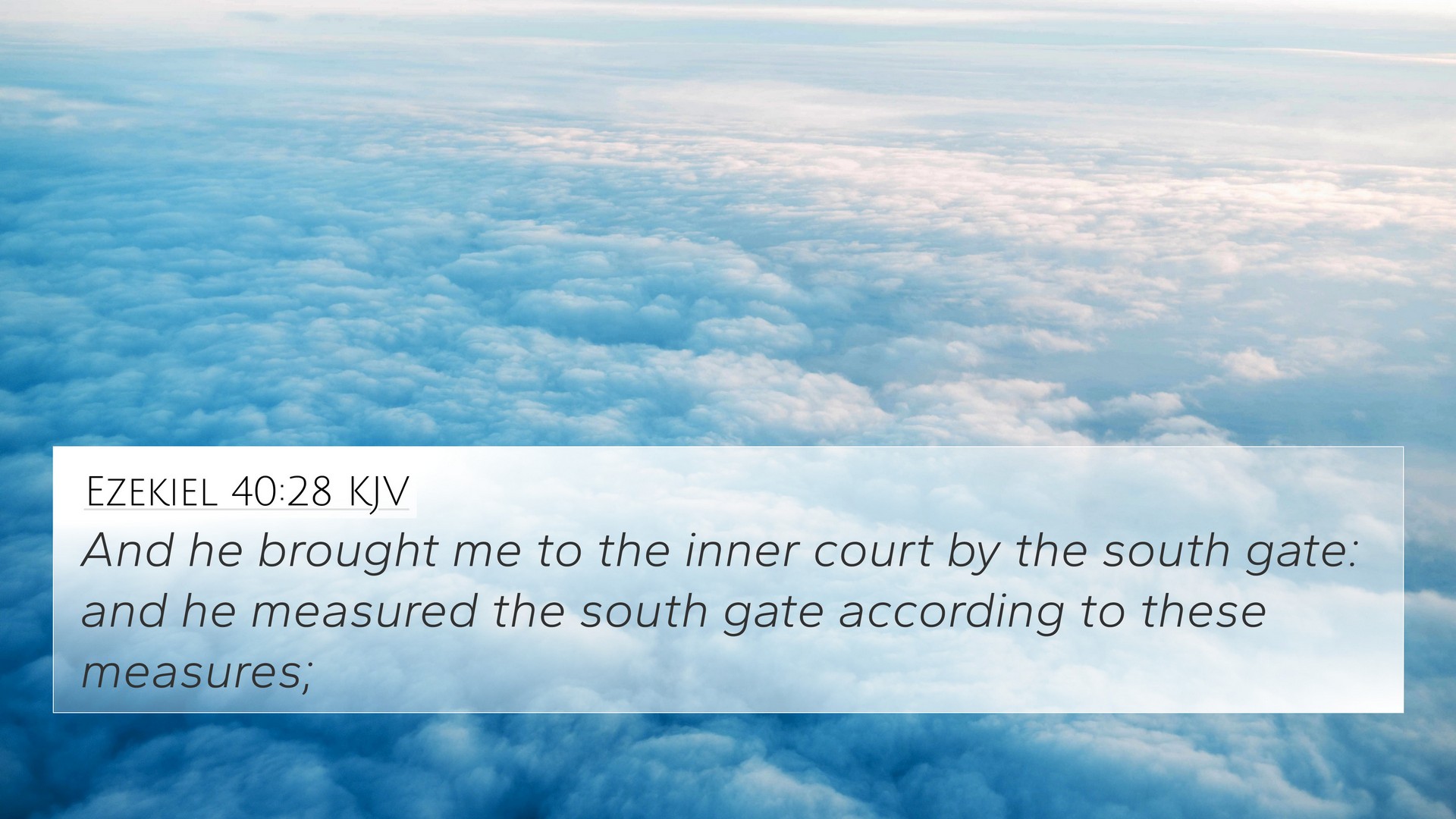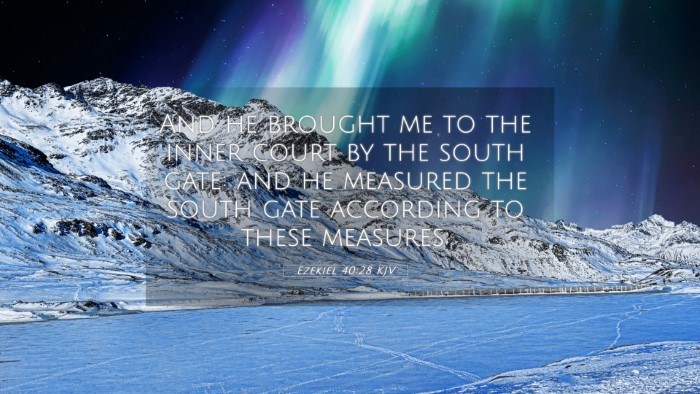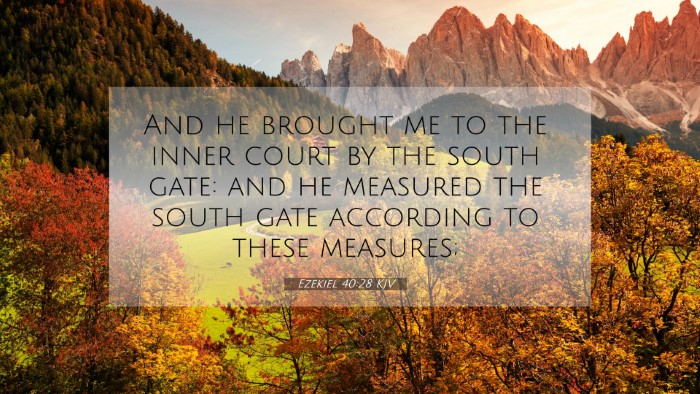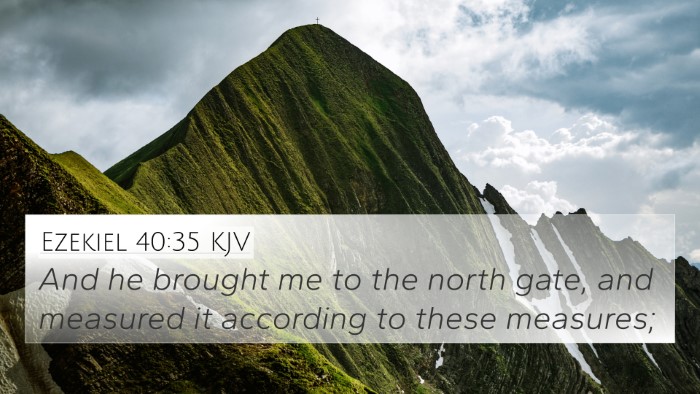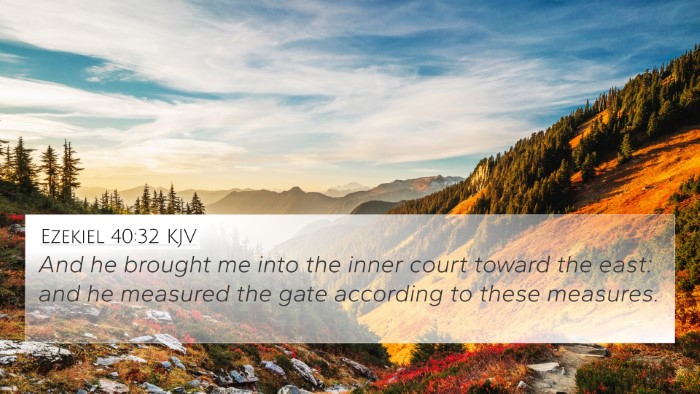Ezekiel 40:28 - Understanding the Verse
Ezekiel 40:28 describes a specific part of the vision that God gave to the prophet Ezekiel concerning the future temple. In this passage, God reveals details about the temple's structure and the significance of its gates. This verse serves as a gateway to understanding the intricate relationship between the Old Testament prophetic visions and New Testament fulfillments.
Summary of Ezekiel 40:28
In this verse, Ezekiel sees the eastern gate of the temple, which is notable for its beauty and design. The mention of the gate signifies God's intention for a place of worship where His presence dwells among His people. Furthermore, the details highlight the holiness and orderliness that God desires in His divine architecture.
Commentary Insights
The insights gathered from public domain commentaries such as those by Matthew Henry, Albert Barnes, and Adam Clarke provide a rich understanding of Ezekiel 40:28:
-
Matthew Henry:
Henry emphasizes the solemnity of the temple's design, suggesting that every detail points to God's majesty and the need for reverence in worship. The gates symbolize the entry points to divine presence, demanding respect and purity from those who enter.
-
Albert Barnes:
Barnes provides a historical view, relating the structure described in Ezekiel to the temple that would be built after the exile. He highlights that these visions were not only for the immediate audience but also set the stage for future revelations about worship and God’s dwelling among His people.
-
Adam Clarke:
Clarke notes the artistic implications of the temple's gate and its significance in the plan of salvation. He connects the temple imagery in Ezekiel to New Testament teachings, suggesting that the presence of God extends beyond the physical temple to the hearts of believers.
Thematic Connections
Understanding Ezekiel 40:28 encourages a deeper exploration of thematic connections within Scripture:
- The Presence of God: The mention of the eastern gate can be linked to John 10:7-9, where Jesus identifies Himself as the Gate through which believers find salvation.
- Symbolism of Gates: Gates often symbolize access to sacred spaces, as seen in Psalm 24:7, which calls for the gates to be lifted high for the King of glory to enter.
- Holiness in Worship: The design and function of the temple relate to 1 Corinthians 3:16, where the Apostle Paul notes that believers are temples of the Holy Spirit.
- Fulfillment of Prophecy: Ezekiel's vision anticipates the future kingdom of God, connecting to Revelation 21:22, where there is no temple but the Lord God Almighty and the Lamb are its temple.
- Restoration of Israel: Ezekiel's emphasis on the temple signifies hope for Israel's restoration, akin to Jeremiah 30:18, which discusses restoration and rebuilding.
- Divine Order: The structured layout of the temple serves as a metaphor for divine order in 1 Corinthians 14:33, affirming that God is not the author of confusion.
- New Covenant Insights: The symbolism of the temple transitions to the New Covenant in Hebrews 9:11, where Christ's sacrificial role is highlighted in relation to the heavenly sanctuary.
Cross-References
Ezekiel 40:28 can be cross-referenced with several other scriptures to uncover deeper meanings and connections in the Bible. Here are some relevant cross-references:
- Revelation 21:1-4 - A vision of a new heaven and new earth, linking to God's eternal plans.
- Isaiah 60:11 - Refers to the gates of Jerusalem that shall not be shut, symbolizing God’s everlasting presence.
- Ephesians 2:19-22 - Discusses believers being part of God's household, aligning with temple imagery.
- Matthew 21:12-13 - Jesus clearing the temple, showing the importance of purity in worship spaces.
- Hebrews 10:19-22 - Speaks of confidence in entering the holy places by the blood of Jesus, resonating with the themes in Ezekiel.
- Zechariah 14:20-21 - Indicates that even the pots will be sacred in the house of the Lord, reinforcing holiness.
- Luke 19:46 - Jesus declares the temple should be a house of prayer, emphasizing its intended purpose.
Applying Ezekiel 40:28
The application of Ezekiel 40:28 in modern life brings out valuable lessons concerning worship and spirituality:
- Respect for Sacred Spaces: Understanding that places of worship are to be treated with reverence and sanctity.
- Preparation for God’s Presence: Just as the temple was prepared for God, so must we prepare our hearts for His presence in our lives.
- Encouragement of Community Worship: Promoting unity and reverence in collective worship settings, reflecting the communal aspect of the temple.
- Emphasis on Holiness: Recognizing that we are called to be holy as God is holy, which echoes the standards set in the Old Testament.
- Hope in God’s Promises: Just as Ezekiel’s vision was a promise of restoration, we hold onto the hope found in God’s Word for our lives.
Conclusion
Ezekiel 40:28 serves as a pivotal point for understanding the nature of God’s invitation to worship and His desire for relationship with humanity. Through the significance of the western gate and the broader context of the temple, we find enduring truths that resonate throughout the Scriptures. Engaging with cross-references, we can deepen our biblical understanding and appreciate the thematic connections woven throughout the biblical narrative.
